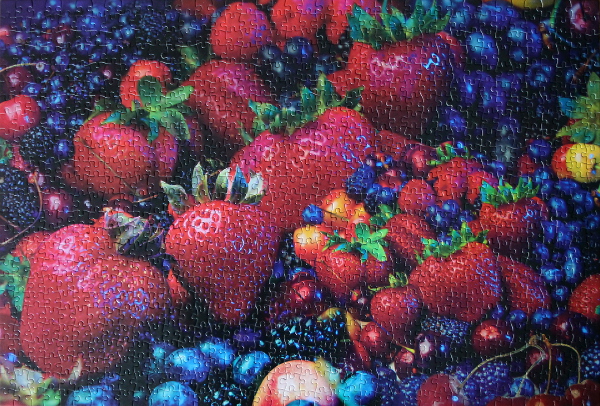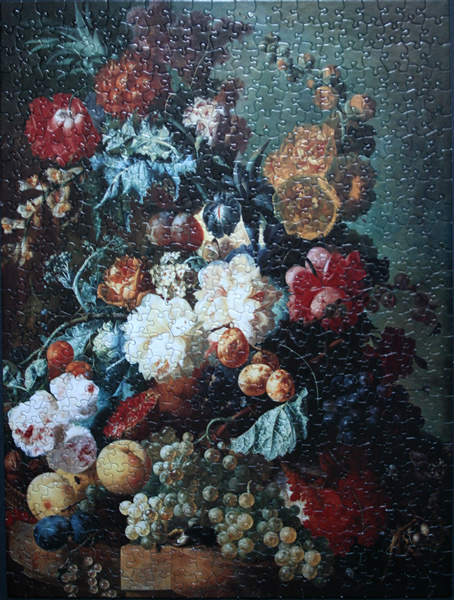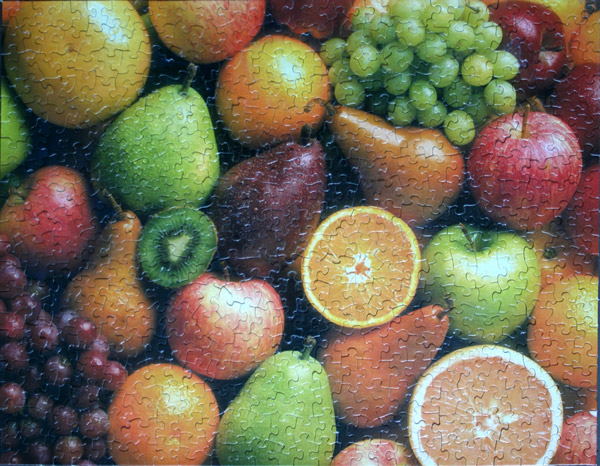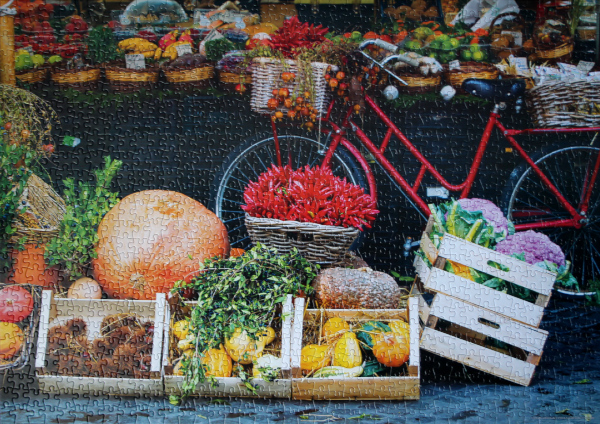
Size: 1000 pieces
Available for purchase on eBay
Dimensions: 48.26 cm x 68.58 cm
Manufacturer: The Canadian Group, #43407
Photographer: Studio Dagdagaz
Box: photo
Tag: fruit
Puzzle: Mixed Berries Collage
Size: 1000 pieces
Dimensions: 73 cm x 48.5 cm
Producer: TCG, Sure-Lox, Collage series, 2014, #44719-4
Photographer: Alix Mullins
Puzzle: From the same series as Shell Game, this deliciously-looking puzzle is a bit more complicated, due to many repetitions of similar colours and texture patterns. I liked starting with the green leaves and distinct colours — light blue of the bottom blueberries, bright yellow, peach and orange fruit, and the cherry stems in the bottom right and top left. For the rest, the assembly was leisurely, larger strawberries coming together first with smaller berries later filling in the gaps. The Sure-Lox pieces make the assembly quite enjoyable.
“Sure-Lox™ is a trusted quality brand. This collection of puzzles features extra thick puzzle pieces that are fully interlocking and uniquely shaped. Sure-Lox™ puzzles come in a durable, restorable box! All designed to make puzzling more fun! Image is everything!” [Puzzle box]
“Lose yourself in the entrancing imagery of the Collages artistic puzzle collection. Enjoy the challenge of piecing together these fun and playful collages of beautifully photographed subjects, like mouth-watering foods, creative crafts and more! Rich with vibrant colours and exceptional detail, these collages make for incredible works of art.” [Puzzle box]
Puzzle: Symphony in Red by Nava Grunfeld
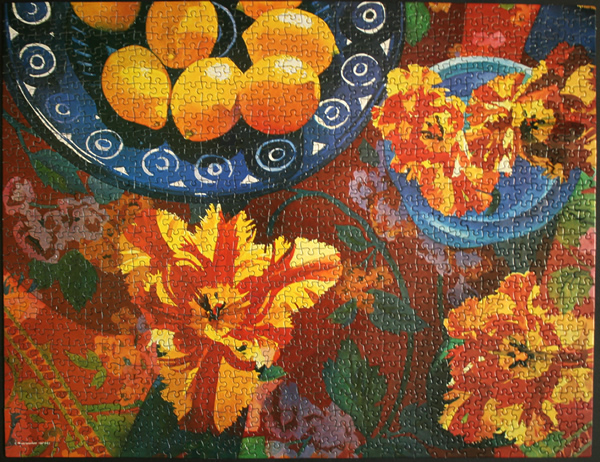
Size: 1000 pieces
Dimensions: 51.12cm x 66.52cm
Producer: Hasbro, MB Puzzles, Big Ben, Artist Series, Nava Grunfeld, 2008
Puzzle: This puzzle is not trivial, but not significantly difficult either. Large blue dish with white spirals and smaller blue dish give a good outline to the top half of the puzzle. Lemons can be filled in afterwards, as well as the lilac-coloured flowers. From that point on, green, yellow, orange, red, and brown patches are equally challenging: I ended up finishing with the tulips, but perhaps a reversal might have been easier.
Artist: Artist Nava Grunfeld was born in Sweden and grew up in Israel, where she began to closely observe nature. She is known for her bold watercolor paintings of still life objects, fruit and flowers. Her technique of layering multiple veils of transparent color onto each painting brings a luminous quality to her work. Like a stained glass window, the white of the paper acts as the light source that glows through the colors. [Puzzle box]
Puzzle: Wild flowers & summer wine

Size: 1000 pieces
Dimensions: 73cm x 48.57cm
Producer: Sure-Lox, The Canadian Group, Canvas Collection series, 2011, #44716-1
Artist: Stephen Darbishire/Rosenstiel
Puzzle: There are multiple regions of the puzzle that can be done independently: fruit, cheeses, yellow/green grass, blue cloudy patch of sky, wooden table parts, bottom of the window, and the chair cushion. From that point on, the window frame, the bright tablecloth top and plates, the lilac of the mountains, and the dark blue/purple of the tablecloth can be completed. The tree branches, the white of the sky, the remaining bouquet, and the dark curtain and bottom left corner remain. Very pleasant and calming puzzle to do, due to a variety of patterns, vivid colours, and serene imagery.
Wild flower: A wild flower is a flower that grows in the wild, meaning it was not intentionally seeded or planted. The term implies that the plant probably is neither a hybrid nor a selected cultivar that is in any way different from the way it appears in the wild as a native plant, even if it is growing where it would not naturally.
Puzzle: Still life with fruit and flowers by Jan Van Os, Dutch
Size: 500+ pieces
Dimensions: 89.5cm x 71.5cm
Producer: Battle Road Press
Artist: Jan Van Os, Dutch (1744-1808)
Painting: Oil on canvas, Gift of Mrs. John Harris Clay, 92.13, The J.B. Speed Art Museum, Louisville, Kentucky, ISBN 0-934967-76-8
Notes: Jan Van Os was born in the small Dutch town of Middleharnis in 1744, but spent most of his life in The Hague, Holland, where he studied with the painter Aart Schoumann. Although Van Os occasionally painted marine subjects, he built his reputation on still-life paintings like the one in the Speed’s collection. He frequently exhibited at the Society of Artists in England and sold many of his paintings to members of the English and French aristocracy. Scholars today credit Van Os with perpetuating the Dutch flower-painting tradition and the style of the leading still-life artist, Jan van Huysum (1682-1749), into the late eighteenth and early nineteenth centuries.
Still Life with Fruit and Flowers is characteristic of Van Os’s large, abundant still-lifes. In it, he depicted a variety of colorful and occasionally exotic plants and fruits in a sculpted terra-cotta vase placed on a marble ledge. Van Os employed two different techniques to render the textures of the various objects. He applied wet paint on a web underlayer and blended the colors to create the subtle variations in tone in the landscape. For the fruit, insects and water drops, however, Van Os painted over a dry underlayer to depict their crisp edges and details.
Like many Dutch artists, Van Os relied on traditional metaphors or symbols to convey meaning in his paintings. In Still Life with Flowers, Van Os contrasted images which suggested the sinful, material world with objects related to the spiritual realm of God. The cat, for example, was often associated with witches, and therefore was commonly thought of as evil or lustful. The mouse was considered an earthbound animal that relied on the material world for survival. Shown eating, as it is here, the mouse also symbolized gluttony. Other objects in the painting that allude to sin are the peaches, emblems of physical pleasure, and the melon, once thought of as a luxurious unhealthy fruit. In contrast to these negative images are objects which serve as reminders of God. The butterfly and dragonfly, for example, symbolize the resurrected soul. The three-part shape of the iris is like the three-part nature of the Trinity. The grapes and the small red currants refer to the wine of the Eucharist or Communion, and thereby symbolize the blood of Christ.
Van Os’s detailed studies of fruit and flowers in lush landscape settings made his paintings immensely popular among collectors during his lifetime, as well as among museums and collectors today.
The J.B. Art Speed Museum was founded by Hattie Bishop Speed as a memorial to her husband, James Breckinridge Speed. Since opening its doors in 1927, the J.B. Speed Art Museum has become Kentucky’s largest and most comprehensive public art collection with works by such masters as Rembrandt, Rubens, Tiepolo, Monet and Picsasso. The Museum’s permanent collection consists of over 8,000 works of art spanning 6,000 years of history from Antiquity to the present day. [Puzzle box]
Puzzle: Lilac and Pear Still Life
Size: 500 pieces
Dimensions: 40.64cm x 40.64cm
Producer: Hasbro, MB Puzzle, Big Ben series
Notes: Syringa (Lilac) is a genus of about 20–25 species of flowering woody plants in the olive family (Oleaceae), native to woodland and scrub from southeastern Europe to eastern Asia, and widely and commonly cultivated in temperate areas elsewhere.
The usual flower colour is a shade of purple (often a light purple or lilac), but white, pale yellow and pink, and even a dark burgundy color are also found. The flowers grow in large panicles, and in several species have a strong fragrance. Flowering varies between mid spring to early summer, depending on the species. The fruit is a dry, brown capsule, splitting in two at maturity to release the two winged seeds.
Lilacs are popular shrubs in parks and gardens throughout the temperate zone. In addition to the species listed above, several hybrids and numerous cultivars have been developed. The term French lilac is often used to refer to modern double-flowered cultivars, thanks to the work of prolific breeder Victor Lemoine. Lilacs will grow in a wide variety of soil types and prefer neutral to slightly acidic soil. [Wiki]
Puzzle: Fruit – Pears, Apples, Grapes, Oranges, Kiwi
Size: 1000 pieces
Notes: I do not have a record of the dimensions or the producer of this puzzle as I do not have the box anymore. A clarification is welcome – if you have any clue as to the details regarding this puzzle, I would much appreciate that information.
The pear is any of several tree species of genus Pyrus and also the name of the pomaceous fruit of these trees. Several species of pear are valued by humans for their edible fruit, but the fruit of other species is small, hard, and astringent.
The genus Pyrus is classified in subtribe Pyrinae within tribe Pyreae. The apple (Malus domestica), which it resembles in floral structure, is also a member of this subcategory.
Pears grow in the sublime orchard of Alcinous, in Odyssey vii: “Therein grow trees, tall and luxuriant, pears and pomegranates and apple-trees with their bright fruit, and sweet figs, and luxuriant olives. Of these the fruit perishes not nor fails in winter or in summer, but lasts throughout the year.”
The pear was also cultivated by the Romans, who did not eat them raw: Pliny’s Natural History recommended stewing them with honey and noted three dozen varieties. The Roman cookbook attributed to Apicius, De re coquinaria, has a recipe for a spiced, stewed-pear patina, or soufflé. [Wiki]
Puzzle: Kota Bharu Market
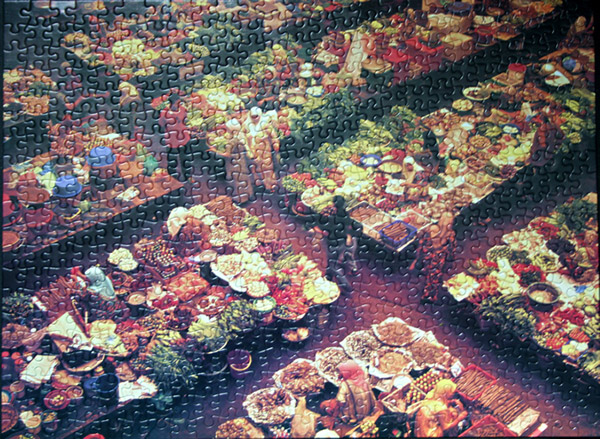
Size: 500 pieces
Dimensions: 48.4cm x 35.5cm
Producer: Sure-Lox, Wonderful World series, #42210-38
Notes: Kota Bharu is a city in Malaysia, is the state capital and Royal City of Kelantan. It is also the name of the territory (jajahan) in which Kota Bharu City is situated. The name means ‘new city’ or ‘new castle/fort’ in Malay. Kota Bharu is situated in the northeastern part of Peninsular Malaysia, and lies near the mouth of the Kelantan River.
This northeastern Malaysian city is close to the Thai border, and is home to many mosques. Also of interest are various museums and the unique architecture of the old royal palace (still occupied by the sultan and sultanah and off-limits to visitors but viewable from outside) and former royal buildings (which can be visited) in the center of town. [Wiki]
Puzzle: Fruitful Bounty
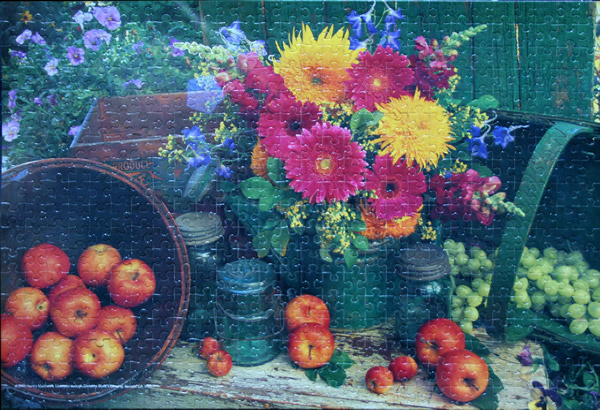
Size: 500 pieces
Dimensions: 33.02cm x 48.26cm
Producer: 2005 Warren Industries, Kodacolor, #20500
Location: A bounty (from Latin bonitās, goodness) is a payment or reward often offered by a group as an incentive for the accomplishment of a task by someone usually not associated with the group. Bounties are most commonly issued for the capture or retrieval of a person or object. They are typically in the form of money. By definition bounties can be retracted at any time by whomever issued them.
The term bounty is used in the mathematics, computer science, and free culture communities to refer to a reward offered to any person willing to take on an open problem in that domain; for instance, implementing a feature or finding a bug in an open source software program. [Wiki]
Puzzle: Tea Time by Barbara Mock
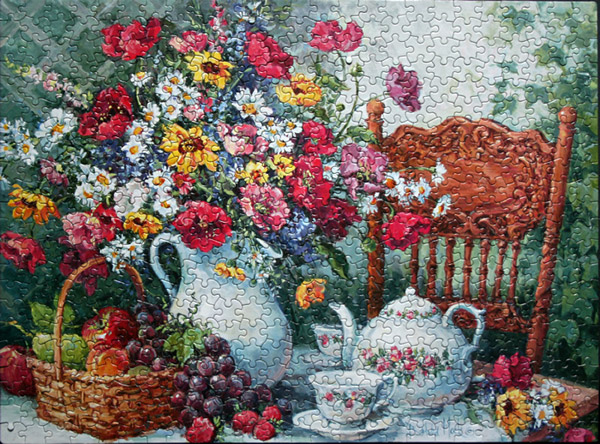
Size: 500 pieces
Dimensions: 45.72cm x 60.96cm
Producer: Karmin International
Painting: photo
Artist: Barbara Mock
Notes: Afternoon tea traditionally known as low tea, is a light meal snack typically eaten between 2pm and 5pm. The custom of drinking tea originated in England when Catherine of Braganca married Charles II in 1661 and brought the practice of drinking tea in the afternoon with her from Portugal. Various places that belonged to the former British Empire also have such a meal.
Traditionally, loose tea is brewed in a teapot and served in teacups with milk and sugar. This is accompanied by sandwiches (customarily cucumber, egg and cress, fish paste, ham, and smoked salmon), scones (with clotted cream and jam) and usually cakes and pastries (such as Battenberg, fruit cake or Victoria sponge). In hotels and tea shops the food is often served on a tiered stand; there may be no sandwiches, but bread or scones with butter or margarine and optional jam or other spread, or toast, muffins or crumpets. [Wiki]
Puzzle: Nature’s Bounty
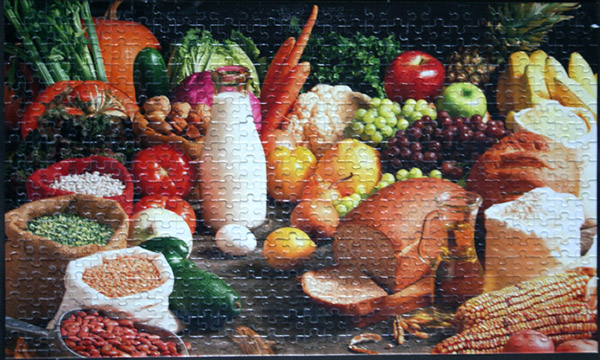
Size: 500 pieces
Producer: RoseArt, Encore series
Notes: bounty (plural bounties)
1. generosity
2. something given liberally
3. A reward for some specific act, especially one given by a government or authority
4. (nautical) formerly, money paid to volunteers for serving in the British navy in time of war
Puzzle: Summer Fruits by W. Hammer

Size: 1000 pieces
Producer: Jumbo
Artist: W. Hammer (1821-1889)
Painting: photo
Notes: In broad terms, a fruit is a structure of a plant that contains its seeds.
The term has different meanings dependent on context. In non-technical usage, such as food preparation, fruit normally means the fleshy seed-associated structures of certain plants that are sweet and edible in the raw state, such as apples, oranges, grapes, strawberries, juniper berries and bananas. Seed-associated structures that do not fit these informal criteria are usually called by other names, such as vegetables, pods, nut, ears and cones.
Fruits are the means by which many plants disseminate seeds. Most plants bearing edible fruits, in particular, coevolved with animals in a symbiotic relationship as a means for seed dispersal and nutrition, respectively; in fact, many animals (including humans to some extent) have become dependent on fruits as a source of food. Fruits account for a substantial fraction of world’s agricultural output, and some (such as the apple and the pomegranate) have acquired extensive cultural and symbolic meanings. [Wiki]
Puzzle: Fiesta Time, Giovanni Simeone

Size: 1500 pieces
Producer: Big Ben
Artist: Giovanni Simeone
Box: photo






